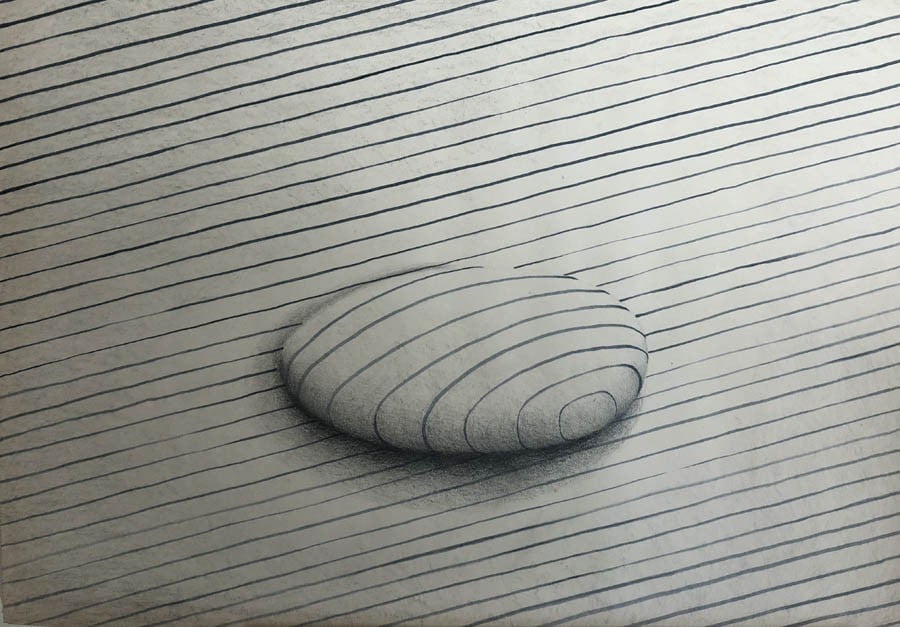
Maryam Rehman’s works at an exhibition at the Koel Gallery Karachi invite quiet contemplation - the value of distilling silence to bring out the crucial intent that lives in the past

We look before and after,
And pine for what is not… Shelley
What are memories composed of - allegories, incidents and events, hindsight, nostalgia, times spent and misspent either in the company of the familiar or the strange, or in solitude? Memories are recollections of the past, as Marcel Proust has encapsulated them in Remembrance of Things Past. Memories evoke emotions and sentiments, and often communicate themselves, in the words of the Impressionist painter, Paul Gauguin as "next to art, next to the purest art, there are other things to say, and they must be said".
Memoirs and autobiographies that form a major preponderance of our literary heritage are, again, reminiscences of doubts, imperfections, passing impressions, contradictions, and varied ambiguities. It seems that in times of transition, desolation and crisis, the logical need to evoke the past becomes insistent. And like the protagonist of Le Grand Voyage proclaims, "what matters most in your life are some of the people you have known".
Inspired by memories of times spent with Lalarukh, Maryam Rehman has dedicated a series of mixed-media drawings on paper to the late artist that went on display at Koel Gallery in Karachi recently. Devoid of realistic images, the drawings can be interpreted as a scaffolding of impressions in which the power of suggestion supersedes image making. In an attempt to relate the circumstances of her life and the influences that she received, the artist has gone on a personal search following inner pathways. The result is neither a literal translation nor a crass illustration of her emotions. Instead, the drawings are a series of explorations where memories take on an abstract form.
At the very outset, the artist presents us three poems drawn from different sources as a pretext for her drawn images: Ghalib’s ghazal (that also lends its refrain as the title to the show Koi Din Aur):
Lazim tha ke daikho mera rasta koi din aur
Tanha rahey kyun, ab raho tanha koi din aur
Shah Hussain’s kafi: Maaey ni mein kinoon aakhan, dard vichhorey da haal ni
And Waris Shah’s quatrain: Heer aakhdi jogiya jhooth aakhey / Kaun vichhray yar milaunda ae?
Whereas Ghalib wrote the ghazal on the occasion of his son’s still birth, Maryam Rehman finds in it resonance of her longing for the woman, Lalarukh, who was both a nurturing spirit and a teacher to her.
The exhibition brochure says, "Many fairy tales begin with the phrase ‘Once upon a time’ which tends to inaugurate something that occurred in the past and that continues to feed into the present and future, whether there is a foreseeable happy ending involved or not. With every utterance of ‘once upon a time’, the uniqueness of the narrative is established and confirmed, and yet it also offers a comforting familiarity - an entry point into a different time and place. It is indeed a description of time and place that transports us to the realm of the imaginary, where we are confronted with anxieties and fears". Rehman, however, transcends the specificities of time and place to create works that configure themes of loss and anxiety in abstract signs and symbols. Memory is a powerful tool; we know ourselves through a remembered past. Rehman’s drawings draw their wistful power from a heroic struggle against disappearance and what it leaves behind – the visual traces of its dispersion.
Dismissive of the desire for painting that tackles a formal problem or tells a story, Rehman seems to have no interest in picturing emotions welled up by memories. It is, as if the artist wishes to proclaim that the body does not like to be illustrated; it demands greater meanings that go beyond the skin. Painters often hang paintings on subjects like clothes on a hanger but because a painting is painted in time, they also hang intuitions, insights, emotions and desires on it as well.
A close look at Rehman’s drawings does indeed reveal a degree of significance beyond their non-objective aspect. They are cast in a subtly symbolic pictorial language of an intensely imaginative and sensual nature. The shapes and drawings are assembled in fully coherent compositions on paper. Meandering lines, spots, and pigment applications provide a visual structure devoid of reference to recognisable objects. Surprisingly robust forms interact with ever so capriciously progressing lines. Drawn and undrawn surfaces, fullness and emptiness, give each other reciprocal support. The viewer soon realises that he is looking at a fount of ideas. Are there references to the uncertainty of time, to the void from which the organic proceeds, to the nature of nervous networks, to the virtual presence of reality? All questions, suggestions or understanding are well worth exploring when viewing her drawings. It must however be added that they carry an intensity of their own, and do not require cultural or historical references to be appreciated. Emotions are couched in balanced shapes, subject to objective references, and the result of rigorously structured lines and forms.
For those of us who live in Lahore, Rehman’s work embodies the dulcet inclinations of Lahore’s winter light. From some angles, this tethered expanse of numerous lines and shadows embody a moment of stillness, on a winter so cold the sunlight might have frozen.
The notable thing about this set of works is that it invites quiet contemplation - the value of distilling silence so that one could bring out the crucial intent that lives in the past and becomes confluence of the present. Maryam Rehman’s spare monochromatic approach distances the events as she meshes few elements into imagined bonds. They awaken an inner response of pain and exhilaration, of longing and defeat. After all, memory is about remembering and forgetting.